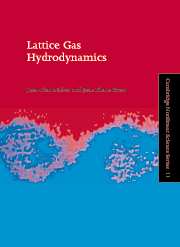Book contents
- Frontmatter
- Contents
- Preface
- Chapter 1 Basic ideas
- Chapter 2 Microdynamics: general formalism
- Chapter 3 Microdynamics: various examples
- Chapter 4 Equilibrium statistical mechanics
- Chapter 5 Macrodynamics: Chapman–Enskog method
- Chapter 6 Linearized hydrodynamics
- Chapter 7 Hydrodynamic fluctuations
- Chapter 8 Macrodynamics: projectors approach
- Chapter 9 Hydrodynamic regimes
- Chapter 10 Lattice gas simulations
- Chapter 11 Guide for further reading
- Appendix Mathematical details
- References
- Author index
- Subject index
Chapter 2 - Microdynamics: general formalism
Published online by Cambridge University Press: 13 October 2009
- Frontmatter
- Contents
- Preface
- Chapter 1 Basic ideas
- Chapter 2 Microdynamics: general formalism
- Chapter 3 Microdynamics: various examples
- Chapter 4 Equilibrium statistical mechanics
- Chapter 5 Macrodynamics: Chapman–Enskog method
- Chapter 6 Linearized hydrodynamics
- Chapter 7 Hydrodynamic fluctuations
- Chapter 8 Macrodynamics: projectors approach
- Chapter 9 Hydrodynamic regimes
- Chapter 10 Lattice gas simulations
- Chapter 11 Guide for further reading
- Appendix Mathematical details
- References
- Author index
- Subject index
Summary
In this chapter, we develop the ‘microdynamic formalism’, which describes the instantaneous microscopic configuration of a lattice gas and its discrete-time evolution. This exact description of the microscopic structure of a lattice gas is the basis for all further theoretical developments, in particular for the prediction of large-scale continuum-like behavior of LGAs.
We first introduce the basic tools and concepts for a general instantaneous description of the microscopic configurations (Section 2.1). The time evolution of the lattice gas is then given in terms of the ‘microdynamic equations’ (Section 2.2). Thereafter, we define microscopic characteristics (e.g. various forms of reversibility), which have a crucial incidence on the macroscopic behavior of the gas, and therefore on its suitability to simulate real physical situations (Section 2.3). The last section is devoted to special rules needed to handle boundary problems (obstacles, particle injections, etc.).
This chapter deals with rather abstract concepts which will find their application in Chapter 3, where lattice gas models are described at the microscopic level.
Basic concepts and notation
The lattice and the velocity vectors
One of the most important features of lattice gases is the underlying Bravais lattice structure which gives a geometrical support to the abstract notion of a cellular automaton. Strictly, a Bravais lattice is by definition infinite. We consider that the cellular automaton only occupies a connected subset ℒ of the D-dimensional underlying Bravais lattice.
- Type
- Chapter
- Information
- Lattice Gas Hydrodynamics , pp. 10 - 33Publisher: Cambridge University PressPrint publication year: 2001



